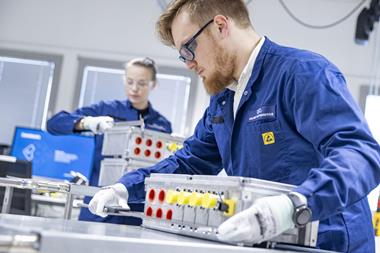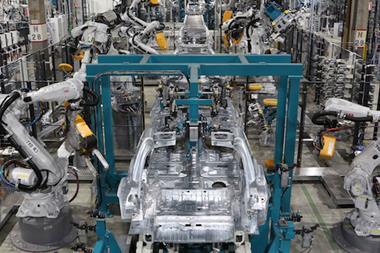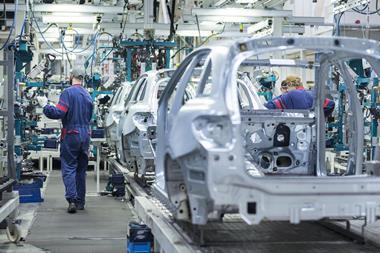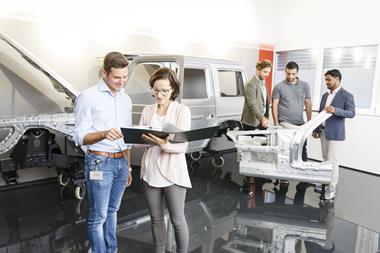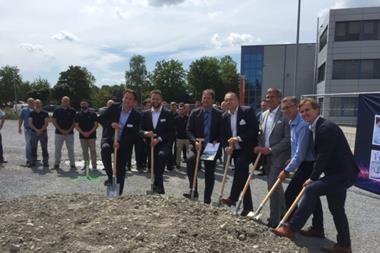 Dr. Reinhold Neitzel on production of the iconic 911 sports car at the company’s Zuffenhausen factory
Dr. Reinhold Neitzel on production of the iconic 911 sports car at the company’s Zuffenhausen factory
Porsche has been building the 911 at the company’s facility in Stuttgart, Germany, since 1964. Now in its sixth generation, the rear-engined car remains as popular as ever with owners and fans alike. Daily output at the factory totals 110 911s of various types, together with 40 Boxsters. Dr. Reinhold Neitzel explains how he has managed to arrange production of the various versions on a single assembly line, while also keeping the plant very lean.
AMS: What has been your main goal over the eleven years you have been director of assembly at Zuffenhausen?
Dr. Reinhold Neitzel: One of my main goals was to build all the sports cars on one line. For this, we have tried to establish a very flexible production system. I believe we are leading the field in model mix production. All versions of the 911 are made on the same line. Two-wheel drive, fourwheel drive, coupes, convertibles, rear engine; mid-engine in the case of the Boxster.
AMS: How does that work? If you’ve got a station designed to produce a rear-engined model, can that station also deal with mid-engined models?
RN: By working very closely with our development department it has been possible to adapt similar equipment for use with different cars. We have very flexible equipment. For example, we have a robot for gluing the windscreen, and that machine supports different programs for different cars. This is supported by the electronic systems that let the machine know what type of car is being presented at a given station. With this, it’s possible to use very precise programs based on the different types of cars.
AMS: How does that work, an RFID code?
RN: No, we read the car when it comes on the line and then we have a calculation based on the takt time at each station (current takt time on the production line is five minutes). On some stations, we also have vision systems (to recognize the model). We know what kind of car is at each station, and the equipment has the flexibility to handle different models. We also have a logistics system that supplies stations with special parts. For example, we have 132 different hand brakes installed on the line. The logistics system corresponds with the model mix so that the right part is delivered at the right moment to the right station.
AMS: This takes advantage of AGV technology?
RN:We have a lot of AGVs in the plant, in engine assembly and also on the production line. We produce various leather parts, for example the instrument panel; these are made in sequence to match model production. Of course, we produce models such as the Carrera Cup on the same line, and these don’t have leather-trimmed instrument panels. But we can produce the race cars on the same line because the system is so flexible. We can deliver instrument panels for the race cars and road cars using the system, despite the fact that they’re totally different.
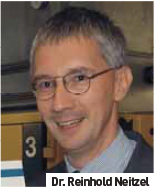 Dr. Reinhold Neitzel studied production engineering and economics in Achim, Germany. After joining Porsche in 1989, he worked with the team responsible for the restructuring of production in the early ‘90s. Following this, he was put in charge of supply chain and supplier quality when the company introduced the 996 version of the 911 and also the Boxster. He has been director of assembly at Porsche (Zuffenhausen) for 11 years, a role which encompasses each element of plant operations, plus production and engineering planning.
Dr. Reinhold Neitzel studied production engineering and economics in Achim, Germany. After joining Porsche in 1989, he worked with the team responsible for the restructuring of production in the early ‘90s. Following this, he was put in charge of supply chain and supplier quality when the company introduced the 996 version of the 911 and also the Boxster. He has been director of assembly at Porsche (Zuffenhausen) for 11 years, a role which encompasses each element of plant operations, plus production and engineering planning.
AMS: How are your suppliers arranged, are they located close to the factory?
RN: Our suppliers are located anywhere from three kilometres away to about 1,000km. The wiring harnesses comes from Slovakia. Four days before a car goes into production, we give the options information about the car to the supplier. They produce those harnesses in two days, with a further two days for delivery. I have one day of stock at the plant. Our axle supplier is much closer to the plant. Every 30 minutes, a truck delivers six pairs of axles. This is good for about 30 minutes of production. These suppliers only have between four and five hours to deliver the parts before they are needed at the plant.
Suppliers of the larger modules produce and deliver in the same sequence we have on the line. Our production is based on a just-in-time and just-in-sequence logistics system. We have very little stock in the plant; most parts and modules are delivered as required.
AMS: What is your opinion on modules, keeping in mind that you hand over responsibility for part quality to the company delivering the module? Are you prepared to do that?
RN: It’s no problem. Our axle suppliers are carefully selected, as are other suppliers, such as our brakes, which are delivered by Brembo. We design the parts and they handle the assembly and delivery. Our suppliers are very close to the system. In a production set up like this, you need very close contact with your suppliers to make the system work. Before I became director of assembly, I was responsible for the suppliers; if there were any problems, you get an immediate breakdown in your plant.
AMS: Do you do random testing on supplier-delivered modules and parts?
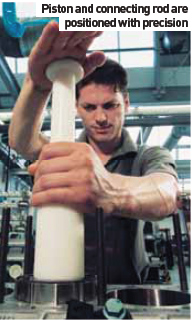 Since entering production in 1964, all Porsche 911s have featured a flat six-cylinder engine, meaning that the engine has two horizontally opposed banks of three pistons. This, says the company, puts the 200kg engine weight lower in the car, improving handling dynamics. The carmaker’s Zuffenhausen facility produces an average of 500 engines per day. Assembled just-in-sequence to match 911 and Boxster production, the plant produces approximately 20 different engine versions. As most of these include proprietary parts, a network of 12 AGVs delivers components just-in-time to the engine assembly line. A further nine AGVs are used to transport completed engines to a holding area. Unlike the vehicle assembly area, which employs magnetic tape to guide the carts, AGVs in the engine assembly area follow magnets embedded in the fl oor at fi ve metre intervals. Travelling at 5km/h, these AGVs can cover up to 20km per day between the parts supermarket and the assembly hall, on a route that includes a bridge and a lift. Engine production at Zuffenhausen is largely a manual process, with robots completing only a small number of repetitive tasks. An example of this is the joining of the two halves of the crankcase, which requires each of the bolts to be torqued to a specifi c level. The takt time at each station is 164 seconds, meaning each engine takes approximately six hours to assemble. Every engine is cold tested, a computer checking against linkage and system parameters as the unit is electrically cranked and turned. One out of every 100 units is removed from the line and fi lled with fl uids for hot testing. Each hot test takes about fi ve minutes and covers 220 engine parameters, including full-throttle performance.
Since entering production in 1964, all Porsche 911s have featured a flat six-cylinder engine, meaning that the engine has two horizontally opposed banks of three pistons. This, says the company, puts the 200kg engine weight lower in the car, improving handling dynamics. The carmaker’s Zuffenhausen facility produces an average of 500 engines per day. Assembled just-in-sequence to match 911 and Boxster production, the plant produces approximately 20 different engine versions. As most of these include proprietary parts, a network of 12 AGVs delivers components just-in-time to the engine assembly line. A further nine AGVs are used to transport completed engines to a holding area. Unlike the vehicle assembly area, which employs magnetic tape to guide the carts, AGVs in the engine assembly area follow magnets embedded in the fl oor at fi ve metre intervals. Travelling at 5km/h, these AGVs can cover up to 20km per day between the parts supermarket and the assembly hall, on a route that includes a bridge and a lift. Engine production at Zuffenhausen is largely a manual process, with robots completing only a small number of repetitive tasks. An example of this is the joining of the two halves of the crankcase, which requires each of the bolts to be torqued to a specifi c level. The takt time at each station is 164 seconds, meaning each engine takes approximately six hours to assemble. Every engine is cold tested, a computer checking against linkage and system parameters as the unit is electrically cranked and turned. One out of every 100 units is removed from the line and fi lled with fl uids for hot testing. Each hot test takes about fi ve minutes and covers 220 engine parameters, including full-throttle performance.
RN: Around ten or 15 years ago, we cancelled such tests. It’s too late to carry out quality tests when axles are being delivered to the plant. We’re receiving the axles in sequence, and if those axles fail quality tests, then you have no axles and you have to stop production.
Normally, we try to prove the supplier and establish very strong tests at their location. In most cases, 100% of all major parts go through a quality check. Also, we don’t have the necessary rework machines at our plant, so parts must leave the supplier ready to go.
AMS: Which do you think has the potential to cause more problems, setting up the assembly line or setting up the supply chain?
RN: Both are very complex, but you can only produce our current model mix when you have a very stable supplier base and you are very familiar with the processes, quality control, production steering. Out of the thousands of parts in a single car, if just one supplier fails to deliver, you have to stop the line. So to answer your question, they’re about as difficult as each other.
In regards to assembly, a major advantage is our stable workforce. In another country, it may be difficult to locate sufficient numbers of trained experts. In Zuffenhausen, we have a long tradition of engineering and this reflects in our low employee turnover. This year, we will have 110 employees celebrating 25 years with the company. This is out of about 1,300 employees in my cost centre.
AMS: What happens when they retire? You want to replace them with the same level of skill, but that must be very difficult.
RN: To successfully deliver our complex model mix, you need a very special logistics system and flexible equipment, but you also need a trained workforce. If you’re producing a convertible at your station, it’s another assembly step over the coupe or race car versions. So the employees have to know the assembly steps for each car. They need a lot of experience, and we have this at Zuffenhausen. But you are right, when they retire, we have to give our new people extensive training to get the same level of quality.
AMS: You mentioned that the racing versions of the 911 are assembled on the same line as the series production cars. How does welding deal with that?
RN: The race cars go through the same welding lines in the bodyshop as the series production cars.
AMS: Can BIW install the roll cage?
RN: This is the only thing we cannot accomplish in the plant. The roll cage is added at a special supplier; it takes between one and two days.
AMS: In regards to convertibles, Valmet used to do the roof for the Boxster, but you’ve taken that back in-house?
RN: They (Valmet) still produce a number of Boxsters, but the majority are now being produced here in Zuffenhausen. Valmet is producing the Cayman and Zuffenhausen is producing the new Boxster Spider. The new Spider is proving very popular. The bodies cross the street in the bridge and people stop to watch them go through this transfer area.
AMS: While you have been at Porsche, there must have been many changes in the press shop. Do you use technologies such as laser cut blanks, laser-welded blanks.
RN: We are using tailor-welded blanks and improved materials, high-strength steel for the structure of the car. Our bodyshop has also become more automated over the years. We have more than 100 robots in the bodyshop which carry out about 95% of all welding processes. We use aluminium parts for hoods and doors, so we have other technologies for using this metal.
AMS: When you started to incorporate aluminium in the 911, where do you source the required expertise?
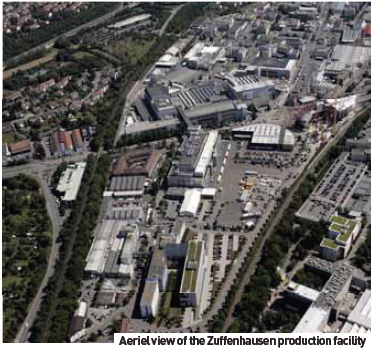 RN: Porsche has a long tradition of using aluminium. In the late ‘80s and early ‘90s, the 928 used aluminium for the doors and wings. We have also used aluminium in our race cars, so we have had the expertise in house for many years. We also benefit from the expertise of other German carmakers. It’s possible to speak with Audi, BMW, Mercedes; experts in this field share information with each other. We also have a lot of suppliers in Germany that have technology discussions with our experts.
RN: Porsche has a long tradition of using aluminium. In the late ‘80s and early ‘90s, the 928 used aluminium for the doors and wings. We have also used aluminium in our race cars, so we have had the expertise in house for many years. We also benefit from the expertise of other German carmakers. It’s possible to speak with Audi, BMW, Mercedes; experts in this field share information with each other. We also have a lot of suppliers in Germany that have technology discussions with our experts.
AMS: Does Porsche use laser welding?
RN: At the moment we’re not using laser. We used it some years ago, but we’ve found better technologies. (Laser welding) is expensive and it has a high risk of defects. If the position of the metal is not correct, you can have problems because you have a very small spot, a very small margin of tolerance.
Body-in-white
Each 911, whether for racing or series production, has a subframe made from three separate stamped assemblies; the front compartment, mid floorpan and rear compartment. The three parts are manually tacked together before being clamped in preparation for automated welding procedures. These joints and other inaccessible areas are then finished with another round of manual welding. While all 911 chassis are identical to this point, the addition of rear side panels starts to define each version as a coupe or cabriolet. After this, robots add piercings for the clips, rivets and screws used in fi nal assembly. The quarter panels and (front) luggage compartment cover are added manually, while robots are used to weld door hinges to the sub-frame. There are almost 5,000 weld points in each 911.
Paint
 Finished bodies travel the 86m to the paintshop over an enclosed glass bridge, a journey that takes about 30 minutes. Washed and dried, the bodies are then dipped in a 60m2 bath of cathodic dip primer. The positively-charged primer is attracted to the negative charge sent through the carrier and car body. Submerged, the carrier agitates the body to ensure complete coverage. After a water rinse, the body is fl ashed to cure the cathodic product.
Finished bodies travel the 86m to the paintshop over an enclosed glass bridge, a journey that takes about 30 minutes. Washed and dried, the bodies are then dipped in a 60m2 bath of cathodic dip primer. The positively-charged primer is attracted to the negative charge sent through the carrier and car body. Submerged, the carrier agitates the body to ensure complete coverage. After a water rinse, the body is fl ashed to cure the cathodic product.
The interior of each body is hand-painted, while the exterior is painted by robots. Again, an opposing charge creates a bond between the body and primer. Bodies are primed using either white, light grey, dark grey, yellow or red, the colour used most closely matching the fi nal topcoat colour. The primer is fl ashed at 170oC for 30 minutes. The top colour coat is added manually from a selection of 12 standard and nine premium colours. Custom colours are available as a cost option. Paint technicians train for three years before working in the paint booths. Painting is completed in a set pattern, top (frontto- back) and then sides. Each car uses between four and fi ve litres of water-based paint, depending on the colour, before being fl ashed at 160oC for 30 minutes. Solvent-based clearcoat is then applied by robots, as the same product is used for each car. Total time in the paintshop for a 911 body is eight hours.
Final assembly
There are 117 station in the assembly hall. Each station has a takt time of fi ve minutes, with each car taking 15 hours to complete this final build stage.
After the doors are removed for kitting at station 1, the wiring loom is added at station 2. At station 7, the cockpit is installed (IPs are kitted adjacent to the main assembly line). 911 Targa models have a 50kg glass roof added at station 14, the assembly inserted through the back of the car. At station 18, the only robot on the fi nal assembly applies an adhesive bead to the windscreen before it is added to the car. Positioning is achieved using infrared sensors, to within tolerances of 0.5mm.
At station 30, the rear wing of the 911 GT3 is installed, while at station 34 the model name is added using specifi c jigs to align the characters. Two radiators are added at the front of the car at station 55 in preparation for the body/powertrain marriage at station 61. Bumpers and rear lights are added at station 77, fl uids for the air conditioning, brakes and power steering at 83, and wheels and tires at 98. All five lugnuts are torqued at the same time, except in the case of the GT3, which requires a separate tool to torque the centre lock wheel mechanism.
At station 99, coupe versions receive rear-side glass and at 103, the cabriolet soft top is added. At 110, kitted doors are returned to the line and at 113, seats are added using lifters. Each car is subjected to a final inspection which takes two hours.
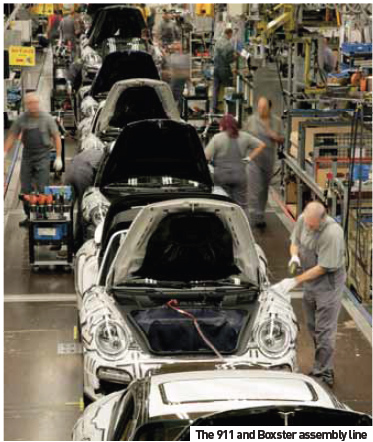 AMS: So you use standard spot welding, brazing?
AMS: So you use standard spot welding, brazing?
RN: We use these and we have special clinching technologies for joining aluminium.
AMS: How does BIW address the complexities of constructing 21 different models?
RN: We use different programs for the robots and we also have different welding heads for the equipment. In some cases, you also need flexible fixtures. For example, we have to change fixtures and fixture frames. For this, we have some geometry stations to ensure precise body measurements.
AMS: Do you use model blocking to simplify production?
RN: No, the bodyshop and assembly shop are totally mixed. We don’t produce a number of each different model. The number of body types is much lower in the bodyshop than it is in assembly. I think there are 14 different bodies that go to making 21 different models. But a lot of these are combinations, where the same body will have sometimes a steel door and another will have an aluminium door.
AMS: So what you have is exactly the same product, from a dimensional aspect, but made out of a different material?
RN: Exactly, though this adds its own complexity. Welding a steel door and an aluminium door requires a different process. Also, welding the convertible body is a little more complex, you have different dimensions and tolerances. It’s also a little more complex to fit together. The different tolerances between steel and aluminium must also be taken into account.
AMS: Is there any hand welding?
RN: We hand-weld a small number of parts, and it is also used to strengthen the floorpan, but it’s a very small part of our operations.
AMS: If you had an unlimited budget, what would you first look to upgrade at Zuffenhausen?
RN: We don’t have enough space at the plant. If I had the budget, I would build a plant like Leipzig (Porsche) on a greenfield site.





























